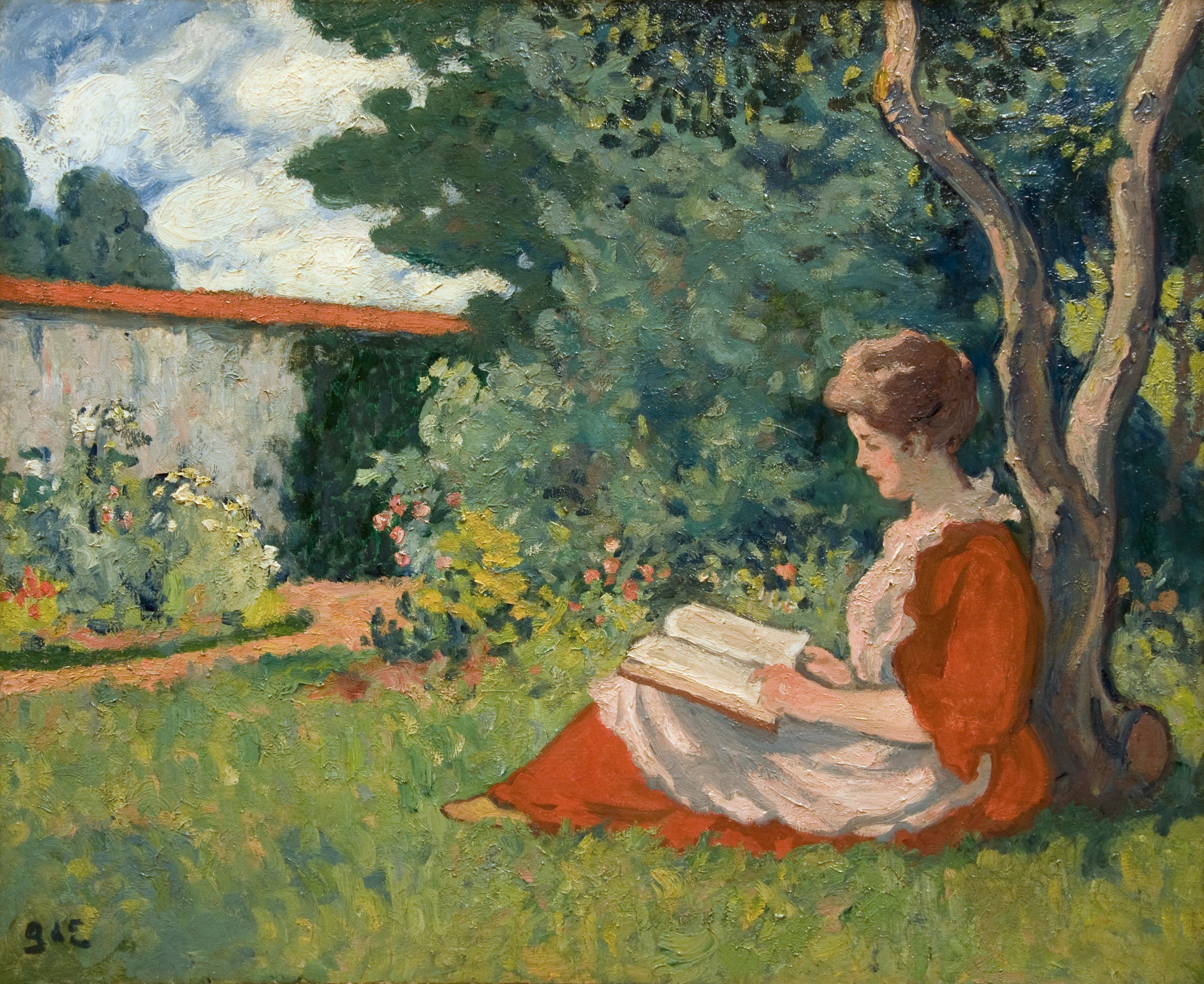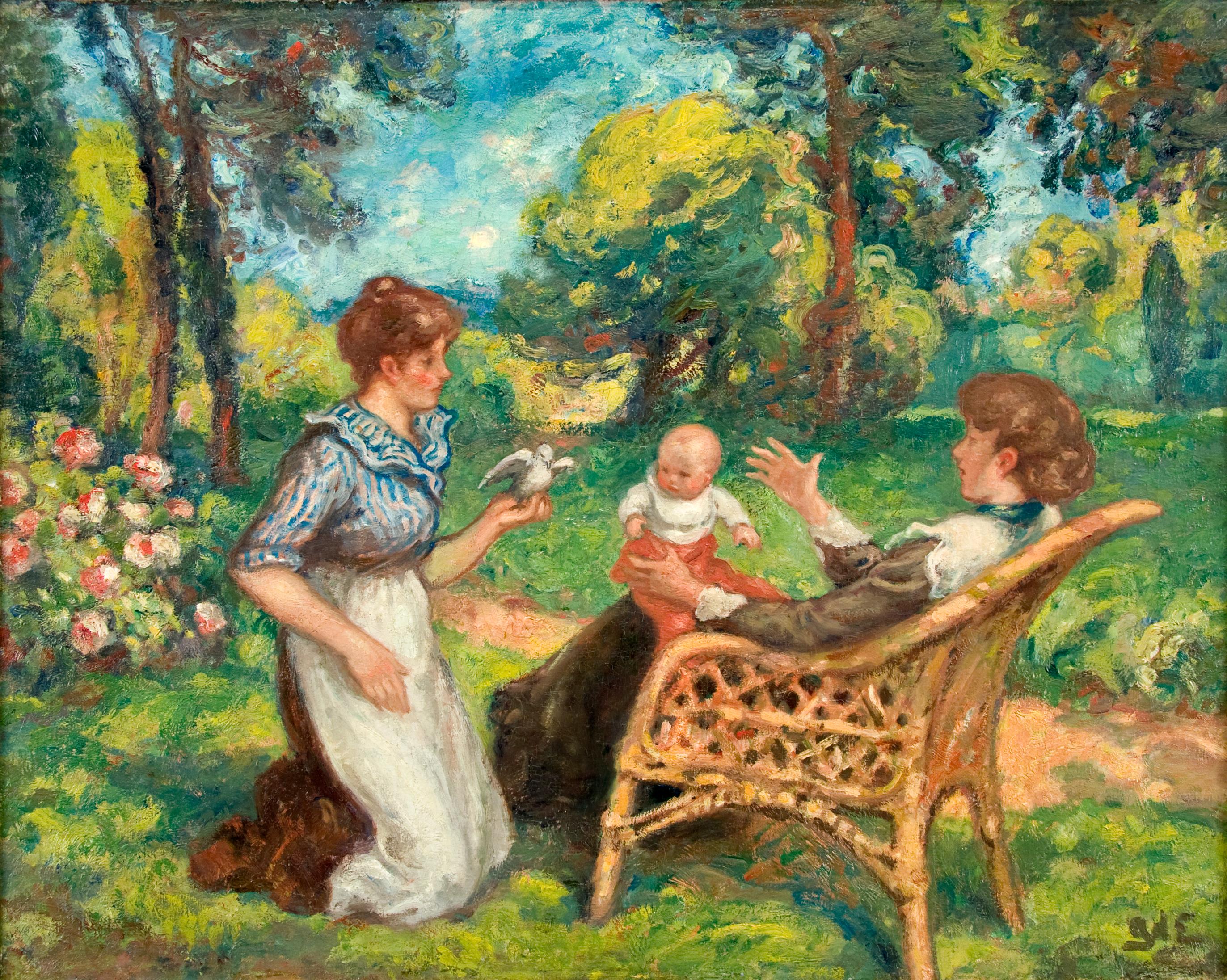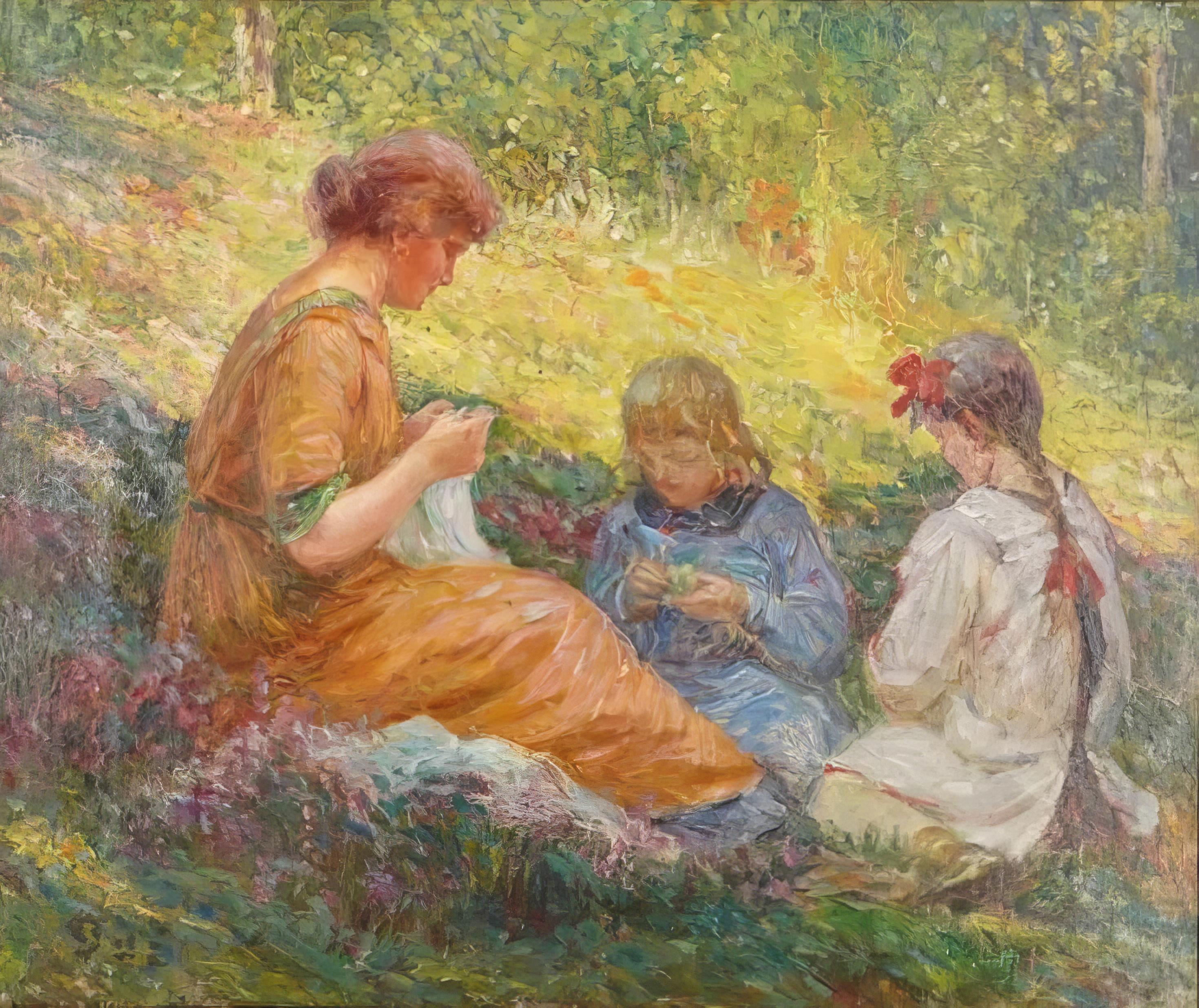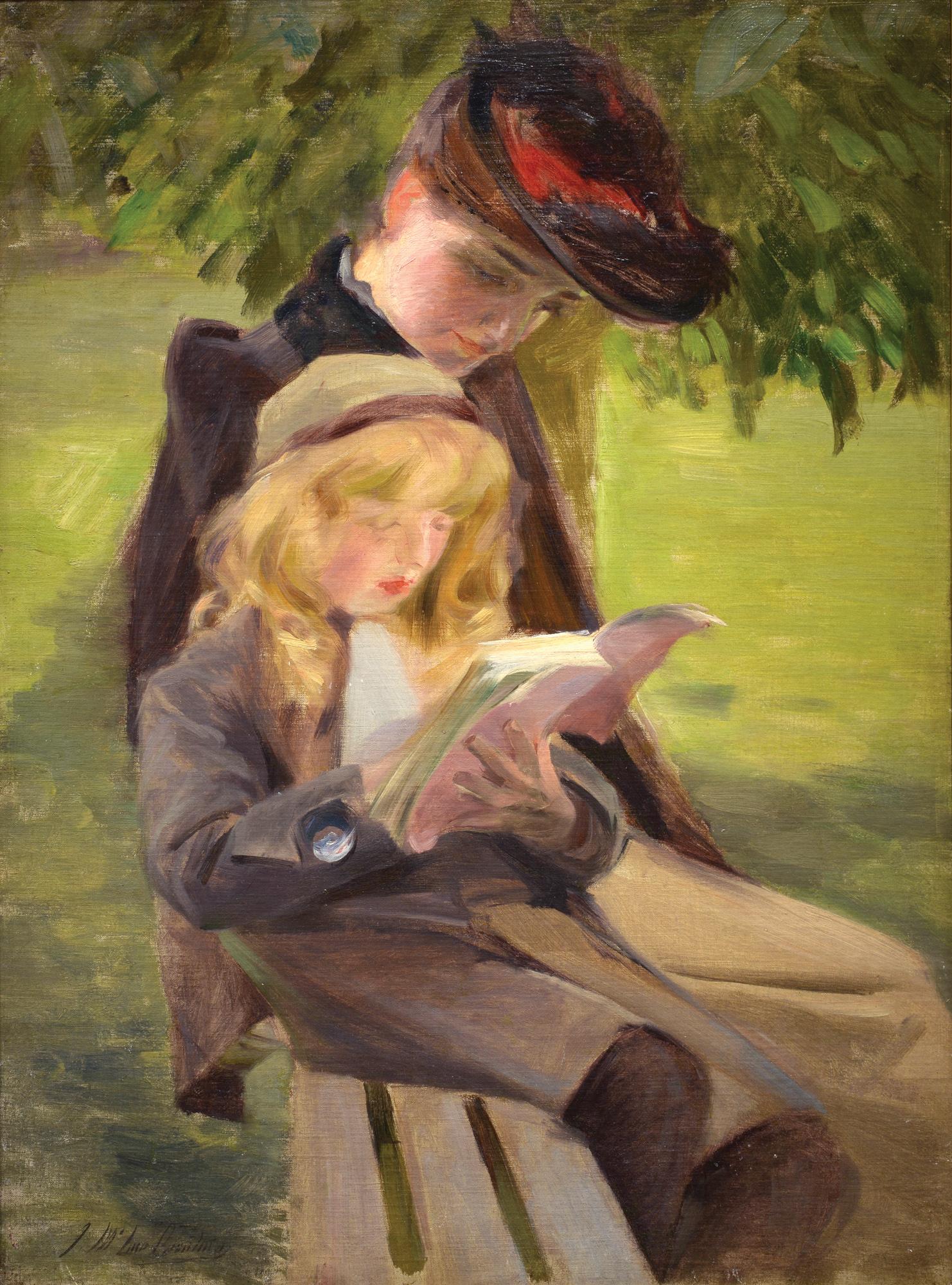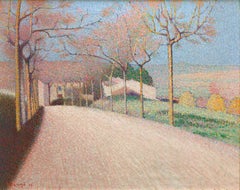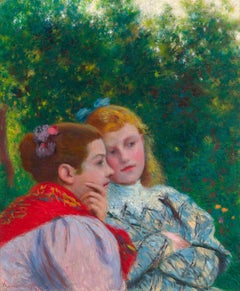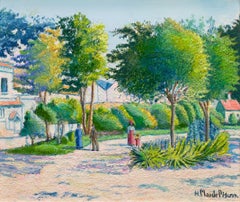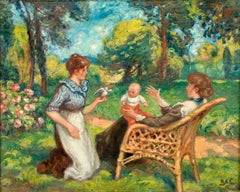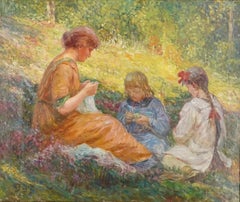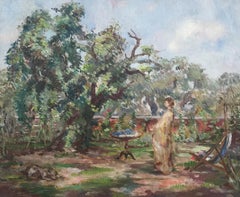Items Similar to La lecture au jardin (Lesson in the Garden)
Want more images or videos?
Request additional images or videos from the seller
1 of 6
Georges d'EspagnatLa lecture au jardin (Lesson in the Garden)Circa 1898
Circa 1898
$248,500
£188,007.32
€216,989.58
CA$347,085.34
A$385,892.61
CHF 201,991.51
MX$4,732,845.07
NOK 2,571,862.76
SEK 2,428,143.24
DKK 1,619,247.47
Shipping
Retrieving quote...The 1stDibs Promise:
Authenticity Guarantee,
Money-Back Guarantee,
24-Hour Cancellation
About the Item
French Post-Impressionist painter Georges d’Espagnat captures a charming moment between a mother and her child in this vibrant oil on canvas. Rendered with a studied use of complementary colors and bold brushstrokes, the painting showcases the artist's unique Post-Impressionist style. Remembered as one of the most individualistic artists of the 20th century, his distinctive canvases bring together the loose brushwork of the Impressionists and the bold color palette favored by the Fauves. Together, they achieve a vibrant spontaneity that lends itself well to the carefree subjects of the present work.
Masterfully composed, La lecture au jardin moves beyond the Impressionist instinct to capture a fleeting moment on canvas. Rather, d'Espagnat succeeds in creating a deep feeling of harmony in the work. Warm colors are perfectly balanced with cool tones, while vertical and horizontal lines are softened by the curves of the foliage and his subjects' figures. Through his simplification of forms and intentional use of color and line, he creates a scene that is carefully designed and thoroughly modern. A similar view of a mother and her child by d'Espagnat is currently in the collection of the Metropolitan Museum of Art (New York).
The Post-Impressionist painter was an individualist since his youth, choosing to forgo traditional schooling in order to independently study the Old Masters in the Louvre. He soon became involved with the most prominent Impressionist and Post-Impressionist painters of the age, including Pierre-Auguste Renoir and Paul Signac, who themselves existed outside the traditional norms of French Academic training. In 1891, he exhibited at the Salon des Refusés, and again the following year at the Salon des Indépendants.
By 1895, he held his first one-man show in Paris, and just three years later his success earned him a solo show at the prestigious Durand-Ruel Gallery. Between 1905 and 1910 he made several trips to visit Renoir on the Côte d’Azur. Their close friendship resulted in a group exhibition at Marcel Bernheim Gallery in 1907, which included the work of d'Espagnat and Renoir alongside Pierre Bonnard, Paul Cézanne, Henri Matisse, Camille Pissarro and other Impressionist and Post-Impressionist greats. It was during this period that he also extended his artistic reach into the realms of illustration and stage design. In 1906, he illustrated Remy de Gourmont’s popular book Sixtine, and later collaborated with Alphonse Daudet on his book L'Immortel. In 1914 he provided the decor for a production of Alfred de Musset’s play Fantasio at the Théâtre de Batignolles in Paris.
In 1920, after working in a camouflage unit during World War I, d’Espagnat bought a country house in the Quercy region, and over the next decade, he painted numerous landscapes and interiors there. Though disrupted by World War II, he continued to paint until his death in 1950.
Circa 1898
Canvas: 55 3/4" high x 42" wide
Frame: 68" high x 53 1/2" wide
References:
“Un Décorateur Nouveau: Georges d’Espagnat,” Art et Décoration, Vol. 6, 1899, by O. Maus, p. 122 (illustrated)
- Creator:Georges d'Espagnat (1870-1950, French)
- Creation Year:Circa 1898
- Dimensions:Height: 68 in (172.72 cm)Width: 53.5 in (135.89 cm)
- Medium:
- Movement & Style:
- Period:
- Condition:
- Gallery Location:New Orleans, LA
- Reference Number:Seller: 31-00081stDibs: LU1867995772
Georges d'Espagnat
Georges d’Espagnat was born in 1870 in Melun, France. He was a painter, muralist, illustrator and theater designer. His family moved to Paris in the 1880s and at the age of 18 he declined the academic training of the Ecole des Beaux-Arts and chose instead to independently study the works of the Old Masters in the Louvre and attend classes at the free academy. In 1891 d’Espagnat began exhibiting at the Salon des Refusees and in the following year exhibited four paintings at the Salon des Independants. He later exhibited at the Salon of the Societe Nationale as well. Although associated with many of the greatest names in 20th century art, and though his work has at various times been identified as Fauve, Nabis or Impressionist, he retained his own individuality. He was influential in the art circles of his time with the likes of Matisse, Gauguin, Picasso, Pissarro and Chagall. d’Espagnat also became closely acquainted with many of the Impressionists and Post-Impressionists including Renoir, Vuillard, Andre, Bonnard and Denis. In 1895 he had his first solo show in Paris and three years later a show at Durand-Ruel Gallery. He was part of a group exhibition in 1907 at the Marcel Bernheim Gallery along with Bonnard, Cezanne, Matisse, Pissarro, Rouault, Suerat and Toulouse-Lautrec while in 1926 his works were a part of another exhibition at the same gallery along with Andre, Bonnard, Braque, Chagall, Matisse, Picasso and Signac. In 1903 d’Espagnat was one of the founding members of the Salon d’Automne and, a year later, became the vice president. In 1906 he collaborated on the illustrations for Remy de Gourmont’s Sixtine, and later worked with Alphonse Daudet on his book, L’Immortel. Traveling extensively throughout his lifetime, D’Espagnat visited Britain, Germany, Italy, Portugal, Morocco and Spain. His work can be found in many museums including the Museum of Fine Arts, Boston; the Musee Royal des Beaux-Arts, Brussels; the Metropolitan Museum of Art, New York; the Art Institute, Chicago; the Pushkin Museum, Moscow and the Musee d’Orsay.
About the Seller
5.0
Vetted Professional Seller
Every seller passes strict standards for authenticity and reliability
Established in 1912
1stDibs seller since 2013
17 sales on 1stDibs
Typical response time: 9 hours
- ShippingRetrieving quote...Shipping from: New Orleans, LA
- Return Policy
Authenticity Guarantee
In the unlikely event there’s an issue with an item’s authenticity, contact us within 1 year for a full refund. DetailsMoney-Back Guarantee
If your item is not as described, is damaged in transit, or does not arrive, contact us within 7 days for a full refund. Details24-Hour Cancellation
You have a 24-hour grace period in which to reconsider your purchase, with no questions asked.Vetted Professional Sellers
Our world-class sellers must adhere to strict standards for service and quality, maintaining the integrity of our listings.Price-Match Guarantee
If you find that a seller listed the same item for a lower price elsewhere, we’ll match it.Trusted Global Delivery
Our best-in-class carrier network provides specialized shipping options worldwide, including custom delivery.More From This Seller
View AllThe Garden Near Cailhau By Achille Laugé
By Achille Laugé
Located in New Orleans, LA
Achille Laugé
1861-1944 French
The Garden Near Cailhau
Signed "A. Laugé 96" (lower left)
Oil on canvas
“Laugé’s art is one of great sensitivity and controlled reason; he is a mas...
Category
19th Century Post-Impressionist Landscape Paintings
Materials
Canvas, Oil
Ces dames au jardin by H. Claude Pissarro
By Hughes Claude Pissarro
Located in New Orleans, LA
Hugues Claude Pissarro
b.1935 French
Ces dames au jardin
(Ladies in the garden)
Signed “H. Claude Pissarro” (lower right)
Oil on canvas
In this composition, French artist H. Clau...
Category
20th Century Post-Impressionist Landscape Paintings
Materials
Canvas, Oil
Les deux soeurs by Federico Zandomeneghi
By Federico Zandomeneghi
Located in New Orleans, LA
Federico Zandomeneghi
1841-1917 Italian
Les deux soeurs
(The two sisters)
Signed and dated "Zandomeneghi 95" (lower left)
Oil on canvas
Two sisters enjoy a quiet moment in a rich green landscape in this intimate oil on canvas from Federico Zandomeneghi. An Italian painter by birth who became a fixture in the Parisian Impressionist scene, Zandomeneghi is best remembered for his sentimental and affectionate scenes of women in both domestic and public spheres.
Zandomeneghi’s creative and technical prowess in composition is highlighted in this painting. The artist deftly frames the young pair in the lower register of the canvas, imbuing the work with a remarkably observational feel. The girls pensively gaze off to the right, lost in thought; Zandomeneghi allows the viewer to witness a natural moment of discussion and contemplation shared among the sisters. The soft palette employed by the artist gives the whole scene an atmospheric glow, with dappled rays of sunshine breaking through the lush foliage. Though the girls remain in the shaded areas of the landscape, Zandomeneghi’s skillful application of paint allows a brightness to remain nevertheless.
Federico Zandomeneghi was born in Venice to a long line of neoclassical sculptors. As if created to be an artist, Zandomeneghi began his artistic education early, enrolling in the Accademia di Belle Arti in Venice at just 15 years old before transferring to the Academy of Fine Arts in Milan. By 1862, the artist had arrived in Florence, where he became fast acquaintances with several Italian artists dedicated to executing landscape paintings en plein air. Zandomeneghi embraced the spontaneity, seeking to bring unparalleled luminosity to his works.
When Zandomeneghi arrived in Paris in 1874, he found kindred spirits...
Category
19th Century Impressionist Figurative Paintings
Materials
Canvas, Oil
Le jardin municipal, Noisy-le-Sec by H. Claude Pissarro
By Hughes Claude Pissarro
Located in New Orleans, LA
Hugues Claude Pissarro
b.1935 French
Le jardin municipal, Noisy-le-Sec
(The Municipal Garden, Noisy-le-Sec)
Signed “H. Claude Pissarro” (lower right)
Oil on canvas
The Pissarro f...
Category
21st Century and Contemporary Post-Modern Landscape Paintings
Materials
Canvas, Oil
Afternoon Tea by Charles-Joseph-Frédéric Soulacroix
Located in New Orleans, LA
Charles-Joseph-Frédéric Soulacroix
1825-1879 French
Afternoon Tea
Oil on canvas
Signed "F. Soulacroix" (lower right)
A charming trio sits down for afternoon tea in this enchantin...
Category
19th Century Figurative Paintings
Materials
Oil
La Terrasse Devant La Mer By Jean Pierre Cassigneul
Located in New Orleans, LA
Jean-Pierre Cassigneul
b.1935 French
La terrasse devant la mer
(The Terrace by the Sea)
Signed “Cassigneul” (lower left)
Oil on canvas laid on panel
This monumental, three-panele...
Category
20th Century Post-Impressionist Figurative Paintings
Materials
Canvas, Oil, Panel
You May Also Like
Femme lisant dans un jardin
By Georges d'Espagnat
Located in Mc Lean, VA
Signed with monogram lower left
* The Robert Lehman Collection at the Metropolitan Museum of Art contains more paintings (nine) by Georges D’Espagnat than any other nineteenth- or ...
Category
1910s Post-Impressionist Figurative Paintings
Materials
Canvas, Oil
Au Jardin
By Georges d'Espagnat
Located in Mc Lean, VA
Elegant figures in a spring garden with mother and child. Colors are pure and fresh. Has everything that one would want in a D'espagnat . A top 2 % work by this artist .. Signed ...
Category
1910s Paintings
Materials
Oil
$118,000
Young women sewing in the garden
Located in Naples, Florida
Young women sewing in the garden
Category
20th Century Portrait Paintings
Materials
Oil
In the Garden, French school impressionist, original oil on canvas, figurative
Located in Naples, Florida
An early 20th Century French School oil on canvas painting of a lady and her dog in a garden in summertime. This high-quality warm and vibrant, although unsigned, work is deftly pain...
Category
Early 20th Century French School Figurative Paintings
Materials
Canvas, Oil
"Au Jardin" 20th Century French Oil Painting Figures in a Garden Landscape Scene
By Pierre Eugène Duteurtre
Located in New York, NY
A stunning oil painting depicting figures in a garden picking flowers executed in the 20th Century. Duteurtre was known for his charming intimate figurative scenes portraying life in Europe. He was active, picking up subjects from the markets, beaches, parks, restaurants, and home life. This painting comes housed in a stunning carved giltwood frame. Signed lower left.
Art measures 20 x 24 inches
Frame Measures 26 x 30 inches
Pierre Eugene Duteurtre...
Category
Early 20th Century Impressionist Landscape Paintings
Materials
Canvas, Oil
In the Park, American Impressionist, Mother and Child, Landscape, Figures, Oil
Located in Wiscasset, ME
Born in Philadelphia John Hamilton was known for portraits, figure paintings and illustrations. He studied at the Pennsylvania Academy of the Fine Arts with Christian Schuessel and Thomas Eakins and then traveled to Europe where he studied in Paris with Jean-Léon Gerome at the Ecole des Beaux-Arts and at the Royal Academy of Fine Arts in Antwerp. He lived abroad, mostly in London, for many years, although he maintained a Philadelphia address. He was the official painter to the English Prime Minister, William...
Category
Late 19th Century American Impressionist Figurative Paintings
Materials
Canvas, Oil
Read More
Paul Revere Crafted This Silver Coffee Pot 250 Years Ago
Perhaps best known as a Revolutionary War hero, Revere was also an accomplished silversmith, and this pot is now available on 1stDibs.
Degas Portrayed These Exuberant Ukrainian Dancers with ‘Orgies of Color’
Discovered in Parisian cabarets, the performers reenergized the artist’s practice.
